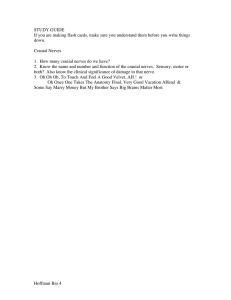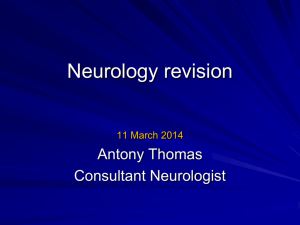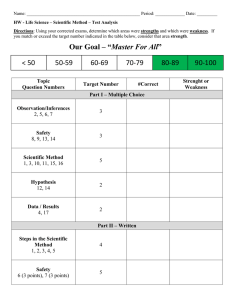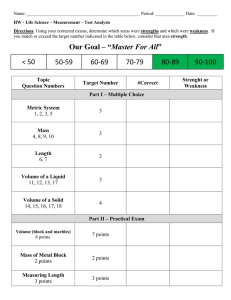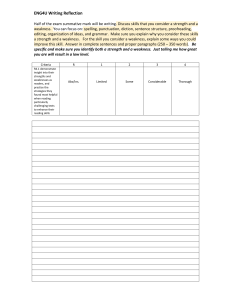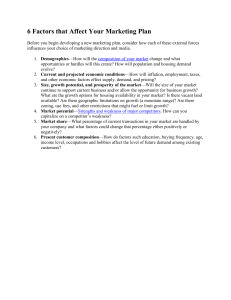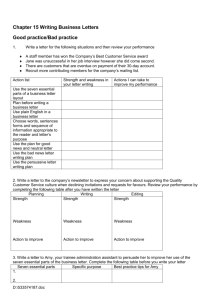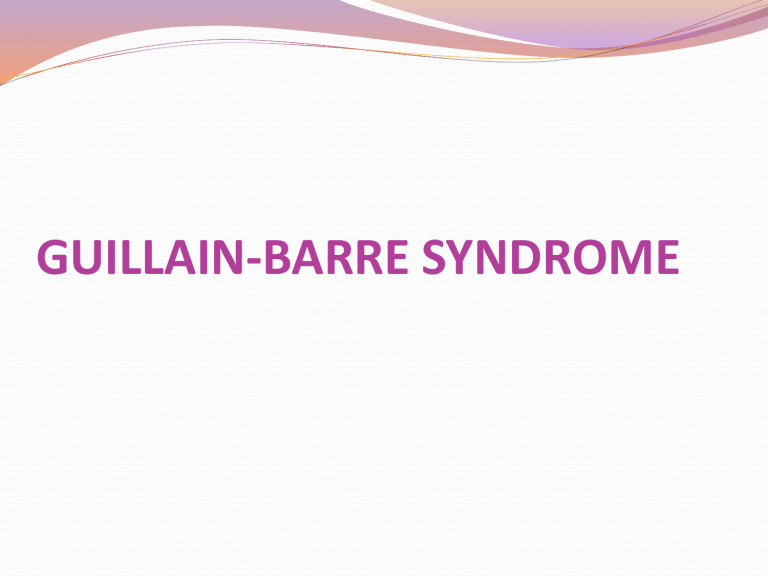
GUILLAIN-BARRE SYNDROME INTRODUCTION Guillain-Barre syndrome (GBS) is the most frequent cause of acute generalized weakness It represents a broad group of demyelinating inflammatory polyradiculoneuropathies. Nerve roots (radiculopathy) and peripheral nerves (polyneuropathy) are a affected. GBS is a classic lower motor-neuron disorder FORMS OF GBS • Acquired inflammatory demyelinating polyradiculoneuropathy (AIDP) • Acute Motor axonal neuropathy (AMAN) • Acute Motor Sensory axonal neuropathy (AMSAN) • Another common variant of GBS is Miller-Fisher syndrome • MILLER-FISHER SYNDROME : a triad of ophthalmoplegia, ataxia, and areflexia. INCIDENCE AND ETIOLOGY GBS is rare with an incidence of 1 per 100,000 people. All age groups, including children and adults. The majority of individuals who acquire GBS experience a respiratory or gastrointestinal illness prior to the onset of weakness and sensory changes. No one causal agent. It is a reactive, self-limited autoimmune disease with a good overall prognosis. PATHOPHYSIOLOGY Involves autoimmune reactions. The immune responses cause a cross reaction with neural tissue. Demyelination follows inflammation. These acute inflammatory lesions are present within several days of the onset of symptoms. Nerve conduction is slowed and may be blocked completely. CLINICAL FEATURES Symmetrical ascending progressive loss of motor function that begins distally and progresses proximally. Distal sensory impairments often present as paresthesias (burning, tingling) of the toes or hypesthesias (an abnormal sensitivity to touch). The sensory involvement varies and is usually not as significant as the motor involvement. CONTD…. Progression of weakness can impair the diaphragm and cranial nerves. Weakness of shoulder elevators and neck flexion parallels diaphragmatic weakness (C3,4,5) Dysautonomia CONTD…. Pain is reported by patients as being muscular in nature (myalgia). Hypesthesias may make using a bed sheet uncomfortable. Half of the patients with GBS have oral-motor involvement in the form of weakness that causes difficulty speaking (dysarthria) and swallowing (dysphagia). CONTD…. The facial nerve (cranial nerve VII) is frequently involved, and bilateral facial weakness is common. Double vision (diplopia) can result from eye muscle weakness secondary to cranial nerves III, IV, and VI involvement. Paralysis of cranial nerves is termed Bulbarpalsy. Cranial nerve involvement is referred to as bulbar because the majority of cranial nerves exit the bulb or brainstem. Absent DTRs Flaccid tone STAGES OF THE DISEASE Acute stage Acute stage lasts up to four weeks. During this time, core symptoms appear: paresthesias, areflexia, weakness in all limbs. The plateau phase Defined by the stabilization of symptoms. While symptoms are present, they are not progressing or getting worse. This phase can also last up to four weeks. Recovery phase Evident when the patient begins to improve. Eighty percent of patients recover within a year but may have some neurologic sequel or residual deficits. The recovery phase can last a few months to several years. Poorer outcome in cases with diaphragm involvement, rapid progression of demyelination, and more distal motor weakness. More the axonal damage poorer is the recovery. MEDICAL MANAGEMENT The mainstay of medical management of patients with GBS is Plasmapheresis Infusion of immunoglobulins Other supportive measures for respiration main management PHYSICAL THERAPY; ACUTE PHASE Supportive care; respiratory care, breathing exercise, postural drainage for airway clearance. ( observe lungs functions regularly) Treat the patient as symptoms are usually progressing Postural care to manage pain and preventing skin breakdown. The patient is positioned to decrease potential contractures with hand and foot splints. Extra care should be taken when performing ROM because denervated muscles can easily be damaged. CONTD…. Avoid overstretching. Be sure that the ankle is in a subtalar neutral position prior to stretching the heel cord. The schedule of positioning, splinting, and the ROM program should be posted bedside. Pain is one of the most difficult symptoms to treat in patients with GBS. Medications are not always effective. Passive ROM, massage, and transcutaneous electrical nerve stimulation may be helpful. CONTD…. Low-pressure wrapping or a snug-fitting garment may provide a way to avoid light moving touch on the limbs. Reassurance and an explanation about what to expect may help alleviate anxiety that could compound the pain. Physical therapy: Plateau phase When respiratory and autonomic functions stabilize, a program to increase tolerance to upright can be begun. Physical therapy goals during the plateau phase include acclimation to upright, maintenance of ROM, improvement in pulmonary function, and avoidance of fatigue and overexertion. The patient is acclimated to sitting upright with appropriate postural alignment and support of the trunk since it may still have minimal innervation. CONTD…. Pressure relief is still provided by changing positions on a regular basis. If the patient continues to experience pain, it may lead to holding limbs in potentially contracture-prone positions. Heat may be used prior to stretching if there is no sensory loss. Return of oral musculature may signal the need for additional team members to work on the movement patterns needed for swallowing, eating, and speaking. Physical therapy: Recovery Phase Muscle strength is gradually recovered two to four weeks after the condition has reached a plateau. The muscles return in the reverse order or descending pattern i.e opposite from the ascending order of loss. As the neck and trunk muscles recover, the patient may begin to use a tilt table for continued acclimation to upright and weight bearing on the lower extremities. Positioning splints may be needed for the lower extremities as well as thromboemolic stockings to decrease venous pooling. CONTD…. Muscles of respiration can be weak if the person required ventilatory assistance, and this weakness may limit tolerance to upright. Physical therapy goals at this time now encompass strengthening and maximizing functional abilities in addition to carrying over any goals from the previous phases.
